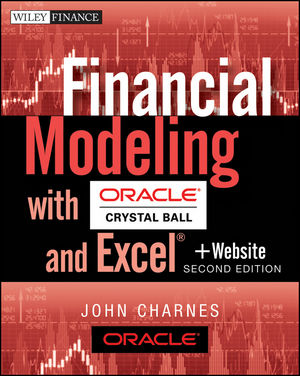This revised and updated edition of the bestselling book on financial modeling provides the tools and techniques needed to perform spreadsheet simulation. It answers the essential question of why risk analysis is vital to the decision-making process, for any problem posed in finance and investment. This reliable resource reviews the basics and covers how to define and refine probability distributions in financial modeling, and explores the concepts driving the simulation modeling process. It also discusses simulation controls and analysis of simulation results.
The second edition of Financial Modeling with Crystal Ball and Excel contains instructions, theory, and practical example models to help apply risk analysis to such areas as derivative pricing, cost estimation, portfolio allocation and optimization, credit risk, and cash flow analysis. It includes the resources needed to develop essential skills in the areas of valuation, pricing, hedging, trading, risk management, project evaluation, credit risk, and portfolio management.
- Offers an updated edition of the bestselling book covering the newest version of Oracle Crystal Ball
- Contains valuable insights on Monte Carlo simulation—an essential skill applied by many corporate finance and investment professionals
- Written by John Charnes, the former finance department chair at the University of Kansas and senior vice president of global portfolio strategies at Bank of America, who is currently President and Chief Data Scientist at Syntelli Solutions, Inc. Risk Analytics and Predictive Intelligence Division (Syntelli RAPID)
Table of Contents
Preface xi
Acknowledgments xvii
About the Author xix
CHAPTER 1 Introduction 1
1.1 Financial Modeling 2
1.2 Risk Analysis 2
1.3 Monte Carlo Simulation 4
1.4 Risk Management 8
1.5 Benefits and Limitations of Using Crystal Ball 9
CHAPTER 2 Analyzing Crystal Ball Forecasts 11
2.1 Simulating a 50–50 Portfolio 11
2.2 Varying the Allocations 22
2.3 Presenting the Results 27
CHAPTER 3 Building A Crystal Ball Model 29
3.1 Simulation Modeling Process 29
3.2 Defining Crystal Ball Assumptions and Forecasts 30
3.3 Running Crystal Ball 33
3.4 Sources of Error 34
3.5 Controlling Model Error 36
CHAPTER 4 Selecting Crystal Ball Assumptions 37
4.1 Crystal Ball’s Basic Distributions 37
4.2 Using Historical Data to Choose Distributions 55
4.3 Specifying Correlations 64
CHAPTER 5 Using Decision Variables 79
5.1 Defining Decision Variables 79
5.2 Decision Table with One Decision Variable 81
5.3 Decision Table with Two Decision Variables 87
5.4 Using OptQuest 98
CHAPTER 6 Selecting Run Preferences 105
6.1 Trials 105
6.2 Sampling 109
6.3 Speed 111
6.4 Options 113
6.5 Statistics 115
CHAPTER 7 Net Present Value and Internal Rate of Return 117
7.1 Deterministic NPV and IRR 117
7.2 Simulating NPV and IRR 119
7.3 Capital Budgeting 123
7.4 Customer Net Present Value 133
CHAPTER 8 Modeling Financial Statements 137
8.1 Deterministic Model 137
8.2 Tornado Chart and Sensitivity Analysis 138
8.3 Crystal Ball Sensitivity Chart 139
8.4 Conclusion 143
CHAPTER 9 Portfolio Models 145
9.1 Single-period Crystal Ball Model 145
9.2 Single-period Analytical Solution 148
9.3 Multi-period Crystal Ball Model 149
CHAPTER 10 Value at Risk 155
10.1 VaR 155
10.2 Shortcomings of VaR 157
10.3 Conditional Value at Risk 157
CHAPTER 11 Simulating Financial Time Series 163
11.1 White Noise 163
11.2 Random Walk 165
11.3 Autocorrelation 166
11.4 Additive Random Walk with Drift 170
11.5 Multiplicative Random Walk Model 173
11.6 Geometric Brownian Motion Model 176
11.7 Mean-reverting Model 180
CHAPTER 12 Financial Options 187
12.1 Types of Options 187
12.2 Risk-neutral Pricing and the Black-Scholes Model 188
12.3 Portfolio Insurance 192
12.4 American Option Pricing 194
12.5 Exotic Option Pricing 197
12.6 Bull Spread 201
12.7 Principal-protected Instrument 201
CHAPTER 13 Real Options 205
13.1 Financial Options and Real Options 205
13.2 Applications of Real Options Analysis 206
13.3 Black-Scholes Real Options Insights 209
13.4 Real Options Valuation Tool 211
CHAPTER 14 Credit Risk 221
14.1 Expected Loss 221
14.2 Credit Risk Simulation Model 223
14.3 Conditional Value at Risk 225
14.4 Using CVaR to Manage Credit Risk 227
CHAPTER 15 Construction Project Management 229
15.1 Project Description 229
15.2 Choosing Construction Methods 231
15.3 Risk Analysis 231
15.4 Stochastic Optimization 234
CHAPTER 16 Oil and Gas Exploration 235
16.1 Well Properties 235
16.2 Statistical Models 236
16.3 Conclusion 239
APPENDIX A Crystal Ball’s Probability Distributions 241
A.1 Bernoulli 241
A.2 Beta 243
A.3 Beta PERT 244
A.4 Binomial 246
A.5 Custom 247
A.6 Discrete Uniform 251
A.7 Exponential 252
A.8 Gamma 254
A.9 Geometric 255
A.10 Hypergeometric 257
A.11 Logistic 259
A.12 Lognormal 260
A.13 Maximum Extreme 262
A.14 Minimum Extreme 263
A.15 Negative Binomial 264
A.16 Normal 266
A.17 Pareto 267
A.18 Poisson 269
A.19 Student’s t 270
A.20 Triangular 272
A.21 Uniform 273
A.22 Weibull 275
A.23 Yes-No 276
APPENDIX B Generating Assumption Values 279
B.1 Generating Random Numbers 279
B.2 Generating Random Variates 282
B.3 Latin Hypercube Sampling 284
APPENDIX C Variance Reduction Techniques 287
C.1 Using Crystal Ball to Value an Asian Option 288
C.2 Antithetic Variates 289
C.3 Control Variates 289
C.4 Comparison 290
C.5 Conclusion 292
APPENDIX D About the Download 293
Glossary 297
References 301
Index 311




